Engine Performance
When it came to power delivery, one machine stood out among the six machines in our 2018 450cc motocross shootout, the Yamaha YZ450F. The 2018 model doesn’t hit as hard as the 2017 did, and yet it feels faster overall thanks to Yamaha’s efforts to make the motor smoother and less tiring to the rider than the previous version. The YZ450F’s, rearward-inclined, fuel-injected, DOHC, 449cc engine boasts intake and exhaust cams with more lift and more duration, which shifts the power higher into the rev range.
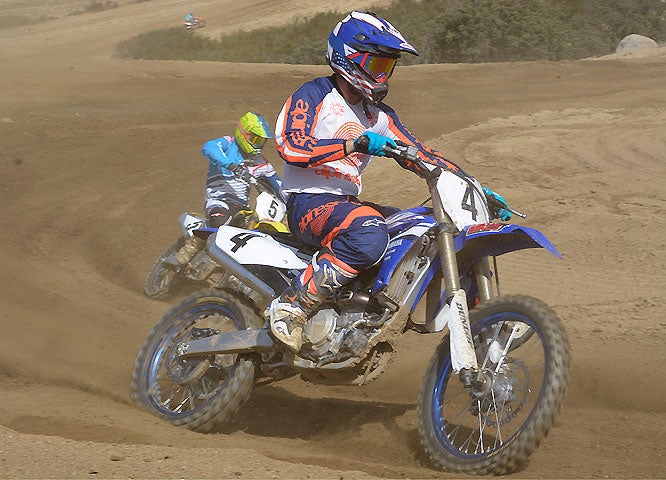
The Yamaha still comes off the bottom with plenty of authority, and it maintains that feel as it pulls through the middle and into its healthy top-end with plenty of overrev. But it doesn’t feel as peaky as the 2017, and that makes it even easier to ride. On the dyno, we expected the Yamaha to make the most horsepower and the most torque in the class, but it didn’t. The YZ pumps out 52.3 rear wheel horsepower (rwhp) @ 9900 rpm and 32.0 lb.-ft. of torque @ 7800 rpm, and every bit of it useable, according to DirtBikes.com lead test rider Ryan Abbatoye.
“The Yamaha has the best power to me out of all of them,” Abbatoye said. “It’s strong and crisp right off the bottom, and its throttle response is the best in the class. It isn’t too much. It’s really smooth off the bottom, and it never seems to run out of top end. It’s pretty seamless all the way through the rev range.”
That was a sentiment echoed by most of our group, including new recruit Ryan Smith, who campaigns in the AMA National Hare & Hound Championship Series.
“It never flattens out,” Smith said. “It just keeps getting stronger. It’s a lot better than last year’s in that it isn’t as jerky. It’s really strong.”
DirtBikes.com test crew regular Nick Stover added, “I’d say it’s the best in class. It’s really exciting, but that could be because it’s actually hooking up and not spinning the tire. It probably has the best transmission in the class, too–very smooth with no hang-ups. The clutch is very smooth as well. It’s a heavier pull than the KTM but not as heavy as the Honda.”
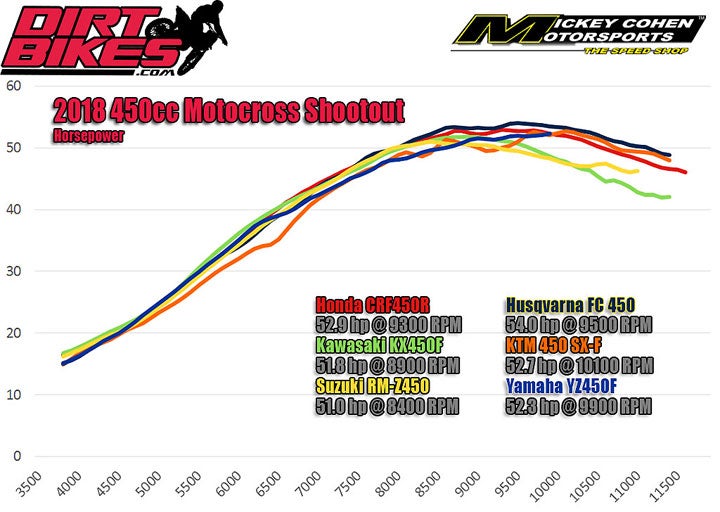
Just like last year, the KTM 450 SX-F was also unanimously praised by our test crew. The 450 SX-F’s 449.9cc, liquid-cooled, SOHC motor doesn’t come off the bottom with as much grunt as some of the other bikes in the category, but it is smooth and exciting as it marches toward its turbo-like top-end. On the dyno, the KTM delivered even more rwhp than the Yamaha, 52.7 @ 10,100 rpm, while churning out 32.0 lb.-ft. of peak torque @ 8000 rpm. On the track, the KTM’s rev-licious top-end drew a lot of praise from our test riders at Cahuilla Creek.
“The KTM is very strong and smooth,” Stover said. “It feels really, really good. It’s exciting power. It’s more of a top-ender. It’s not super strong down low, but it builds and builds. There’s a hit in the middle, and it continues to pull through the top end overrev.”
Smith echoed the sentiments of the crew when it came to KTM’s power character.
“It’s more aggressive than the Husky, but it doesn’t hit as hard as the Honda and the Yamaha, and it pulls harder through the middle up to the top-end,” he said. “The motor revs really well. I had no issues with the KTM’s hydraulic clutch. It was more to my liking than the Husky’s because you don’t have to pull it in as far to feather the clutch.”
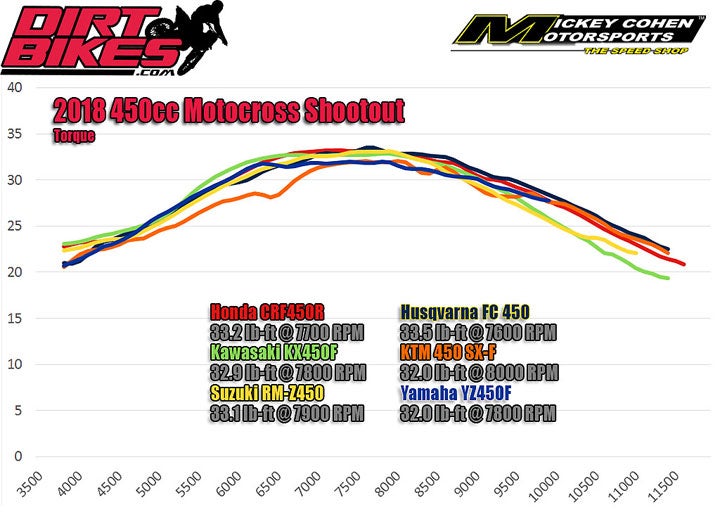
The Honda CRF450R was on the favorable end of the mix in our 2018 450cc motocross shootout as well, ranking third among most of our test crew, who really appreciated not having to try and kick-start the CRF engine, a tricky chore on the’ 17 model. Honda really succeeded in creating a more exciting power plant for the CRF450R last year, and the 449cc, liquid-cooled, Unicam engine is still cool, with snappy throttle response, excellent low-end burst and solid mid-range and top-end thrust. The Honda makes more torque than the KTM and the Yamaha, with 33.2 lb.-ft. @ 7700 rpm, and it’s available sooner than the YZ or the SX-F, which contributes to the CRF’s robust character as it continues to build to an rwhp peak of 52.9 horsepower at 9300 rpm. Like the Yamaha and the KTM, the Honda also maintains a good spread of power past its peak, which makes it fun to ride.
“The Honda has a strong hit off the bottom, and it carries that through the midrange, which means you don’t need to rev it out much because it is already so strong,” Smith said. “The top-end overrev is really good as well. It’s very snappy and responsive. There’s no lag. I did have the motor flame out on me a few times—it was the only bike I had that happen to me—and even with the electric start, it seemed like it was hard to start.”
However, all of our test riders had issues with the heavy pull of the Honda’s cable-actuated clutch.
“The CRF450R has the heaviest clutch pull of any of the bikes in the class,” Abbatoye said, with Stover adding, “The clutch pull is stiff, but engagement feels real good. Nothing stands out about the Honda’s five-speed transmission. It isn’t buttery smooth or too notchy.”
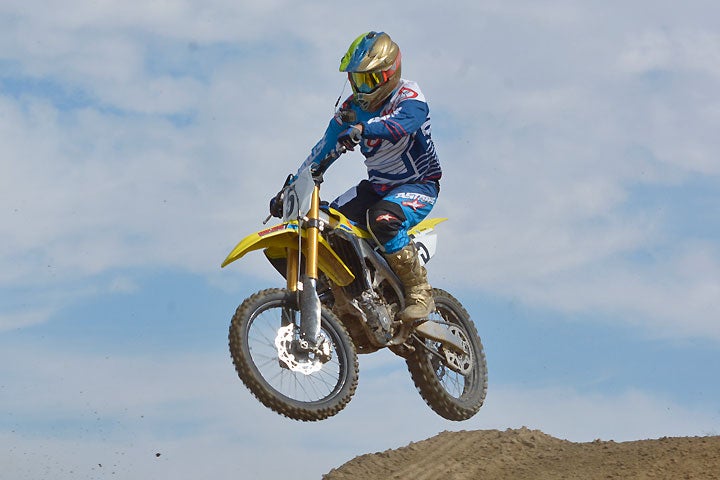
The RM-Z450 clearly benefitted from Suzuki’s engine upgrades, although not enough to vault it to the head of the class. Although not by much, the RM-Z’s revised 449cc, liquid-cooled, DOHC engine makes the least power in the class, but it also recorded the third highest peak torque figure, proving that you don’t have to make the most peak power to attain success in the 450cc ranks. With 51 rwhp on tap @ 8400 rpm and 33.1 lb.-ft. of torque @ 7900 rpm, the Suzuki is still no rev monster. Instead, it appears as if the RM-Z450 engineers focused on simply enhancing the power character that was already there. That includes virtually flawless throttle response and a linear pull that doesn’t fall on its face like the 2017 RM-Z450 did. It gives the RM-Z more breath between gears, which means that you don’t have to row its five-speed gearbox nearly as much.
“The RM-Z450 has a good amount of power off the bottom, good throttle response and good pull through the mid-range and up to the top-end,” Smith said. “It never left me looking for more. It feels closer to the KTM in terms of overall hit. You can nail the gas and break it loose, or you can get it to hook up really easily. It’s really flexible.”
In fact, most of our test riders were surprised by just how improved the RM-Z450 engine really is.
“It surprised me for sure,” Stover said. “It’s so much better than the ’17. It’s actually exciting to ride now. The motor matches the chassis.”
Abbatoye added that the Suzuki engine feels better than it has in years.
“The Suzuki used to have such a short power range, where it ran out super quick, but now it feels like it pulls longer, with more mid-range and top-end,” Abbatoye said. “The new engine definitely solves the problem that the old one had where it ran out of steam on top. You don’t have to shift the 2018 nearly as much.”
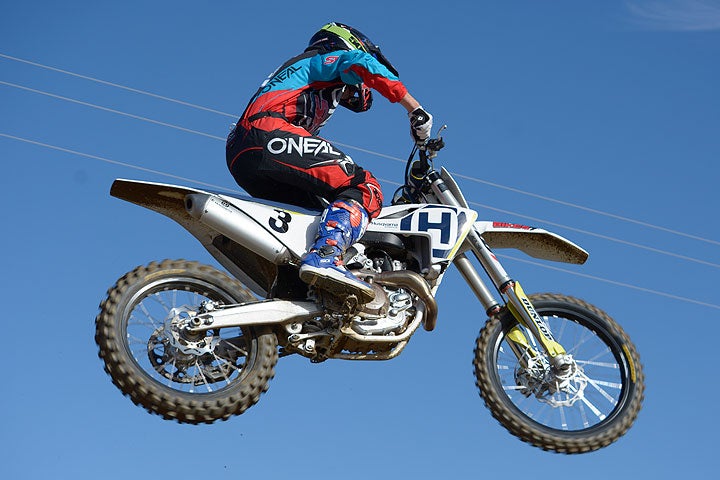
Considering just how close the Husqvarna FC 450 is in overall engine tuning to the KTM 450 SX-F, its fifth-place ranking in the engine performance category of our 2018 450cc motocross shootout is a bit of a head-scratcher that becomes all the more perplexing when you consider that the Husqvarna was also horsepower and torque king during our dyno test. The Husky’s 449.9cc liquid-cooled, SOHC single made 54 rwhp @ 9500 rpm and a whopping 33.5 lb.-ft. @ 7600 rpm—with its peak torque coming sooner in the rev range than any other bike in this comparo. So, what’s the deal? According to our dyno dude, Mickey Cohen, the “problem” is that the Husqvarna’s fuel-injection is so smooth and its torque curve is so linear that it might not feel all that exciting on the track. Indeed, the Husqvarna fooled all of our test crew, who panned it for its lack of snap.
“It just feels a little soft,” Stover said. “I can’t believe it makes the most power. It just doesn’t feel like the mid-range has the hit of the others, and it doesn’t give you the impression that it is making big power. It just drives forward, but it doesn’t light up the rear tire or blow up berms or anything like that.”
“It isn’t a rocket ship, and it feels like it doesn’t want to rev out,” Abbatoye said. “It’s definitely tractable. It doesn’t want to spin the wheel everywhere. It would be good power for off-road racing.”
It was no surprise, however, that the Kawasaki KX450F trailed the others when it came time for our test riders to pick the engine performance hierarchy. Last year we noted that the Kawi’s exhaust note appeared to signal that it was ready to throw down in the power sweepstakes, but instead we determined that its 449cc, liquid-cooled, DOHC engine didn’t have the bite to match its bark, particularly from the mid-range onward. Our 2018 test unit delivered 51.8 rwhp @ 8900 rpm and 32.9 lb.-ft. of peak torque @ 7800 rpm. Those aren’t the lowest numbers in the class in either category, and in fact the Kawasaki delivers the fourth-best torque figure. Still, out on the track our test riders simply wanted more top-end power out of the KX engine than it was willing to deliver.
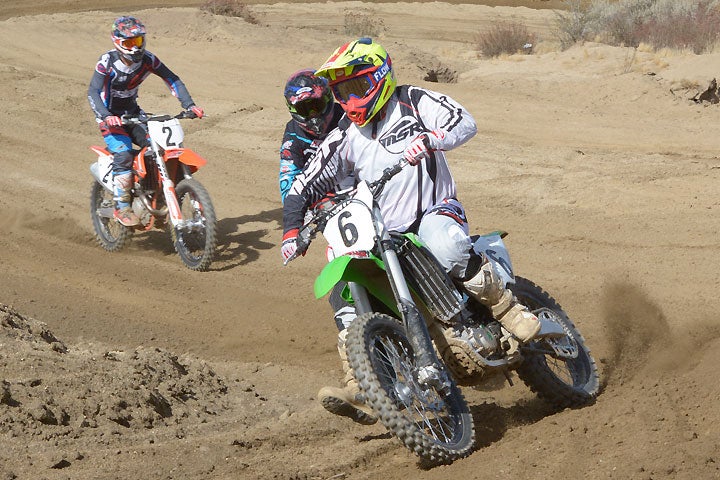
“The KX450F has good low-end and mid-range power, but it isn’t as strong up top as the others,” Stover said. “It likes to be short-shifted, but the transmission feels a little clunky. It’s almost as if you can feel it go into every gear and hear it go into every gear. The clutch pull is smooth but not as light-feeling as the KTM or the Husqvarna. Throttle response is good. It’s pretty snappy, but if you’re an aggressive rider it really doesn’t have the kind of power character you’d want.”
Abbatoye agreed, stating that the KX450F isn’t slow but that it just feels like a 5-year-old engine when put up against the new or upgraded engines in our shootout.
“It could stand to be more finely tuned,” Abbatoye said. “It doesn’t seem to run as crisply as the other bikes in the class.”
However, just as with last year’s bike, we were able to get a more satisfactory power feel by swapping out the KX450F’s stock DFI coupler for the coupler that leans out its fuel-injection mapping.
“I had to go to the lean coupler,” Smith said. “It peps up the motor some, but that still doesn’t bring it to the level of the other bikes in the class. The KX just feels slow compared to the other bikes. It doesn’t rev quickly, and it takes a little more clutch work to get it going.”
2018 450cc Motocross Shootout Engine Performance Results
1. Yamaha YZ450F
2. KTM 450 SX-F
3. Honda CRF450R
4. Suzuki RM-Z450
5. Husqvarna FC 450
6. Kawasaki KX450F
 Your Privacy Choices
Your Privacy Choices